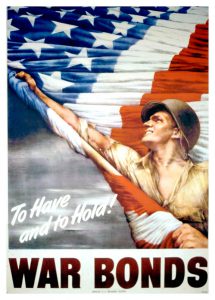 Speaking during the Third War Loan Drive in September 1943, Marshall said, “The American people must give not only their full personal effort but the full use of their dollars invested in War Bonds, to back these attacks. There is no alternative. Total victory is in sight but it can only be won by concentrating every resource of America to the task.” Americans took Marshall’s words to heart as they purchased more than $19 billion in War Bonds during the drive, greatly surpassing the $15 billion goal.
Speaking during the Third War Loan Drive in September 1943, Marshall said, “The American people must give not only their full personal effort but the full use of their dollars invested in War Bonds, to back these attacks. There is no alternative. Total victory is in sight but it can only be won by concentrating every resource of America to the task.” Americans took Marshall’s words to heart as they purchased more than $19 billion in War Bonds during the drive, greatly surpassing the $15 billion goal.
The total amount of money that the United States spent fighting the Axis Powers was more than $300 billion. To finance the war the United States Treasury Department established a bond program allowing citizens to purchase bonds on a voluntary basis. Originally called Defense Bonds when first available for purchase in May 1941, the name was changed to War Bonds after the Japanese attack on Pearl Harbor.
 Purchasing War Bonds was another way for civilians to support the war effort by providing the United States with much needed funds to buy military equipment. It also boosted the morale of the American public by giving people a sense of satisfaction that they were doing their part too. In addition to demonstrating their patriotism War Bonds provided civilians with the opportunity to save for the future since they could be redeemed for their full value 10 years after being purchased.
Purchasing War Bonds was another way for civilians to support the war effort by providing the United States with much needed funds to buy military equipment. It also boosted the morale of the American public by giving people a sense of satisfaction that they were doing their part too. In addition to demonstrating their patriotism War Bonds provided civilians with the opportunity to save for the future since they could be redeemed for their full value 10 years after being purchased.
Americans were constantly encouraged to purchase War Bonds by posters, radio programs, war loan drives, celebrities, cartoon characters, and even comic book superheroes. The appeal to purchase War Bonds extended to children as well who could purchase War Bond stamps for 10 cents or 25 cents to be put into War Bond booklets. During the war eighty-five million Americans purchased War Bonds totaling more than $185 billion.
To learn more about war bonds, visit the newest museum exhibit “What We’re Made Of” in the lower gallery before December 10, 2016.
